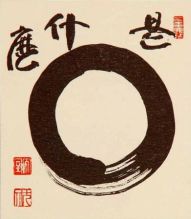
| ... |

|
| ... Laurence Platt recreating |

|
|
Here's the thing about practicing Zen (ie here's the thing about bringing Zen to bear on life, living, and the world): you're coming from things are perfect exactly the way they are and exactly the way they aren't, not because this is the way good people ought to view life, living, and the world and / or hope and believe it's the way it should be ... but because it's the way it already really is. When you get this, you'll notice there's no significance to things being the way they are and the way they aren't: they just are this way. Adding significance to things being the way they are and the way they aren't is more arrogance. Now: so what?! Why do anything if it's already perfect the way it is and the way it isn't? Why bother? Try this on for size: in a transformed context, you do whatever you do and you do it well, not for the points but rather to be with the joy and the elegance of the freedom to create. If you're going to do anything at all, do it to be with the joy and the elegance of the freedom to create. That's true freedom in life. That's true joy and elegance in life. That's what it is to live the / a good life. Doing things with Zen (which is to say doing things to be with the joy and the elegance of the freedom to create) is really what a life well-lived is. There's nothing more to it than that. All the rest is either commentary, opinion, or simply being unclear on the concept ie just talking the walk. I'm watching a master chef (a master baker actually) at work. I have the privilege of being in her kitchen (which is to say in her laboratory) as she prepares to bake a coffee cake from a decades old handed-down family recipe. Now if you say or find yourself thinking something like "What good is coffee cake?" and / or "Aren't there more important things to attend to in our troubled world than coffee cake?" and / or (harkening to Marie Antoinette) "Let them eat coffee cake" ("Qu'ils mangent de la brioche au café"), you not only defile the extraordinary ever-present opportunity for Zen, but you also besmirch one of the quintessential possibilities for being human and being alive endowed with the freedom to create simply for the sake of creating. With joy. With elegance. |

|
Ingredients. • butter: coating + 3 tablespoons + 1½ sticks • 3 eggs • 1½ cups sour cream • flour: sprinkling + ¼ cup unsifted + 3 cups sifted • ½ teaspoon pink Himalayan salt • 1½ teaspoons baking powder • 1½ teaspoons baking soda • sugar: ½ cup + 1½ cups • 1½ teaspoons cinnamon • ¾ cup chopped pecans • 1½ teaspoons vanilla • ¼ cup confectioners' sugar Preparation. Remove butter, eggs, sour cream from refrigerator; wait 1 hour. Coat tube pan interior with butter; lightly sprinkle with flour so it adheres to butter uniformly; cover pan with Saran wrap; set aside. Dry ingredients: in a bowl, mix sifted flour, salt, baking powder, baking soda until evenly dispersed; cover bowl with Saran wrap; set aside. Streusel: in a bowl, mix ½ cup sugar, cinnamon until evenly dispersed; mix in unsifted flour until evenly dispersed; add 3 tablespoons butter; pinch together into a crumble; mix in pecans; cover bowl with Saran wrap; set aside. Batter: in a bowl, cream together 1½ sticks butter, 1½ cups sugar; mix in eggs, vanilla, sour cream; gradually mix in dry ingredients until combined. Baking. Put ½ the batter in pan; sprinkle in ¾ of the streusel; add remaining batter; sprinkle in rest of streusel; bake at 350° for 55 minutes until cake-tester comes out clean; leave in pan on wire rack for 30 minutes to cool before removing; dust with confectioners' sugar from a sieve just before serving. Eat and enjoy. |

|
| Communication Promise | E-Mail | Home |
| © Laurence Platt - 2017 through 2025 | Permission |